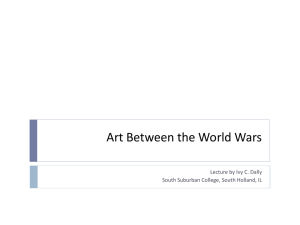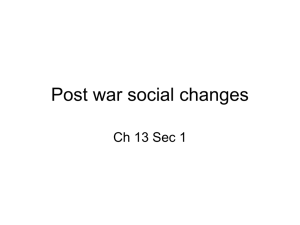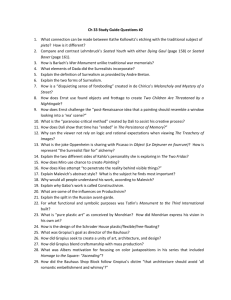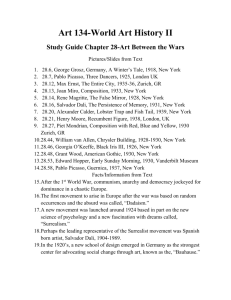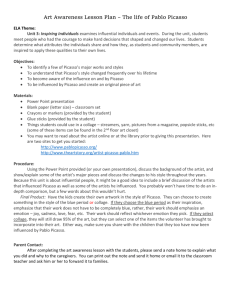Anxiety art show update
advertisement
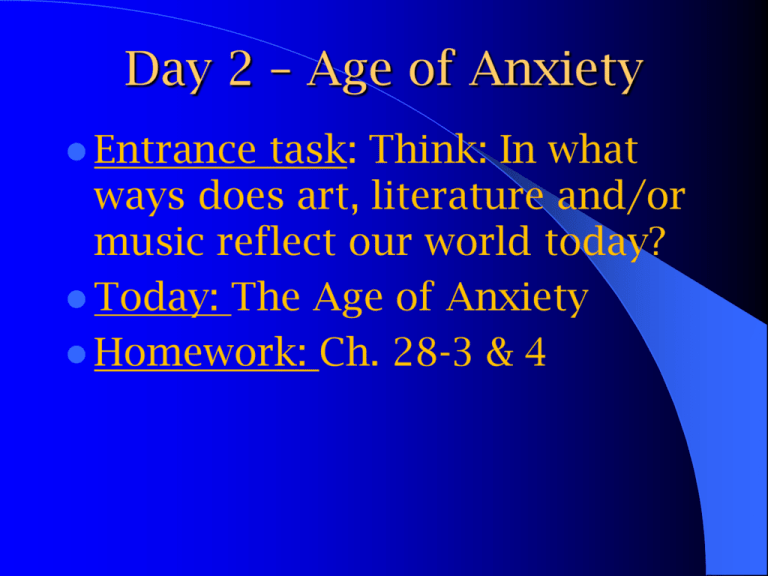
Day 2 – Age of Anxiety Entrance task: Think: In what ways does art, literature and/or music reflect our world today? Today: The Age of Anxiety Homework: Ch. 28-3 & 4 The Age of Anxiety The Interwar Period Uncertainty in Modern Thought The devastation of World War I left many with an increasing uncertainty and a desire to bring meaning and purpose back into life. Uncertainty in Modern Thought Before WWI, most people believed in progress, reason, and individual rights Pre-WWI optimistic views were shattered by the horrors of the war years, as well as the economic crisis that followed Paul Valery (1871-1945) French poet “The storm has died away, and still we are restless, uneasy, as if the storm were about the break. . . . Doubt and disorder are in us and with us. There is no thinking man . . . who can hope to dominate this anxiety, to escape from this impression of darkness.” Paul Valery (1871-1945) “We are a very unfortunate generation, whose lot has been to see the moment of our passage through life coincide with the arrival of great and terrifying events, the echo of which will resound through all our lives.” Paul Valery (1871-1945) “One can say that all the fundamentals of the world have been affected by the war, or more exactly, by the circumstances of the war; something deeper has been worn away than the renewable parts of the machine. . . The Mind has indeed been cruelly wounded; its complaint is heard in the hearts of intellectual man; it passes a mournful judgment on itself. It doubts itself profoundly.” (1922) Shell shock The Horrors of War Friedrich Nietzsche German philosopher (1844-1900) Rejected Christianity because he claimed it glorified weakness “God is dead” The only hope for a person is to accept the meaninglessness of existence and to embrace it Became widely read after his death & WWI Henri Bergson (1859-1941) – French philosopher Believed that experience and intuition were as important as rational and scientific thinking for understanding reality “Think like a man of action, act like a man of thought.” Georges Sorel (1847-1922) French socialist Rejected democracy and believed a small revolutionary elite should firmly rule a socialist society Logical empiricism (positivism) Found followers in English-speaking countries Began with Austrian philosopher Ludwig Wittgenstein (1889-1951) Saw philosophy as the clarification of thoughts that cannot be tested or proven scientifically and/or logically Issues such as God, freedom, morality, etc. are senseless Existentialism Most thinkers were/are atheists Existence precedes essence – People have no predetermined nature or essence that controls what we do – People are free to act independently – People create their own values through their choices and actions Revival of Christianity The horrors of war clearly portrayed the sinful nature of people, the need for faith, the mystery of God’s forgiveness, and the relevance of religion Freudian Psychology Sigmund Freud believed human behavior is basically irrational and is driven by the interaction of three forces: – Id – irrational unconscious – Ego – rationalizing conscious – Superego – Ingrained moral values New Physics Significant scientific discoveries offered some comfort to those disillusioned in the post-WWI period Major contributors – Marie Curie - – Max Planck – Albert Einstein – Ernest Rutherford – Werner Heisenberg The work of people like Sigmund Freud and Albert Einstein added to the confusion and anxiety of the period. Perhaps nothing could truly be known for certain. Post-World War I Art and Architecture Cubism An early 20th-century school of painting and sculpture in which the subject matter is portrayed by geometric forms without realistic detail, stressing abstract form at the expense of other pictorial elements largely by use of intersecting often transparent cubes and cones. Cubism Cubist style emphasized the flat, two-dimensional surface of the picture plane, rejecting the traditional techniques of perspective Cubist painters were not bound to copying form, texture, color, and space; instead, they presented a new reality in paintings that depicted radically fragmented objects, whose several sides were seen simultaneously. Picasso: Dance of the Veils Picasso: Woman in Green Picasso: Bathing Picasso: Composition with skull Picasso: Guernica George Braque – 1929 - Still life Georges Braque's Still Life: Le Jour, 1929 Abstract Wassily Kandinsky born: Moscow, Russia; 1866 died: Paris, France; 1944 Composition VII - 1913 Composition VIII - 1923 Kandinsky – On White Fernand Leger – 1916 – Soldier with a pipe Fernand Leger – Beer Mug Dada Dada [1916-1922] the Dada art movement was anti-art. the name, in French means 'hobby horse‘ pointless as it is, was a symbol for the artists disillusionment and commentary on traditional European and American art and artists. The Dadaists, by using absurd and "non-art" elements in their art, actively rejected the aesthetics of all art that preceded them. Jean Arp : Configuration Jean Arp – The Ballerina Marcel Duchamp Nude descending staircase No.2 Marcel Duchamp – La Jocande aux Moustaches Man Ray - Les Amoureux Surrealism A 20th-century literary and artistic movement that attempts to express the workings of the subconscious by fantastic imagery. Surrealism The movement represented a reaction against what its members saw as the destruction wrought by the "rationalism" that had guided European culture and politics in the past and that had culminated in the horrors of World War I. Salvadore Dali: Illuminated Pleasures Salvadore Dali: Cannibalism in Autumn (dadaism) Salvadore Dali: The Persistence of Memory Yves Tanguy - Indefinite Divisibility Max Ernst – 1919-1920 Little Machine Max Ernst – 1927 - The Kiss Various paintings from the inter-war era Edvund Munch Self-portrailt – between clock and bed (Expressionism) Edvard Munch Scream Piet Mondrian – 1918 Composition with gray and light brown (abstract expressionism) Franz Mark – 1913-1914 Fighting Forms This German artist was killed in WWI Franz Mark – The Fate of Animals Henri Monet – 1916-1923 Water Lillies (Impressionism) Post War Architecture Post war architecture became more functional that earlier work. Frank Lloyd Wright was one of the most influential architects of the period. Frank Lloyd Wright Post war architecture became more functional that earlier work. Frank Lloyd Wright was one of the most influential architects of the period. Wright became known for a simplicity of design that broke with the more ornamental styles of the Victorian age. Frank Lloyd Wright - The Allen House Other developments of the period Lucky Charles Lindbergh made the first trans-Atlantic flight in 1927 Thanks to the success of the assembly line, automobiles were now able to be produced much faster and much less expensively. A new culture based on the automobile was soon to develop. Improvements in radios helped make the world a smaller place as information could now be transmitted to the awaiting public. By the end of the 1920s, radio was an obsession shared by both Europeans and Americans. Motion pictures were also developed during this time. These silent films offered yet another opportunity for entertainment and escape from the everyday chores of life. The End
